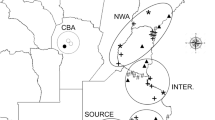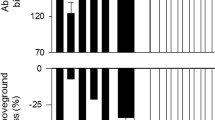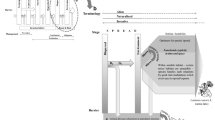Abstract
Several alien plant species have been introduced into Kashmir Himalaya from different regions of the world and subsequently some of these have been able to colonize and become invasive. Why only some species among the alien species pool establish as strong invaders represents a fundamental question for invasion ecologists. Trait comparisons of invasive with less/non-invasive congeners help in understanding the role of various trait differences in invasion success. In this study, we investigated the differences in various phenological, physiological and morphological traits in three alien plant congeners (Amaranthus blitum Linn., A. caudatus Linn. and A. spinosus Linn.) which differ in their invasion status, and attempted to relate the trait differences to their differential invasion potential in Kashmir Himalaya. The results revealed that the more aggressive behavior of A. caudatus in contrast to other two congeneric species is more likely explained by its early and longer germination period, shorter pre-reproductive period, early and extended flowering period, shorter generation time, early life cycle completion, fast growth, high reproductive allocation, more height, inflorescence length and higher seed production. We expect this knowledge to yield theoretical as well as practical information, about the possible adaptive traits employed by the three alien species, to target their long term management in the Kashmir Himalaya.



Similar content being viewed by others
References
Abrahamson WG, Gadgil MD (1973) Growth form and reproductive effort in goldenrods (Solidago, Compositae). Am Nat 107:651–661
Assad R, Reshi ZA, Jan S, Rashid I (2017) Biology of Amaranths. Bot Rev 83:382–436
Bradley BA, Blumenthal DM, Wilcove DS, Ziska LH (2010) Predicting plant invasions in an era of global change. Trends Ecol Evol 25:310–318
Burns JH, Winn AA (2006) A comparison of plastic responses to competition by invasive and non-invasive congeners in the Commelinaceae. Biol Invasions 8:797–807
Colautti RI, Barrett SC (2013) Rapid adaptation to climate facilitates range expansion of an invasive plant. Science 342:364–366
Colautti RI, MacIsaac HJ (2004) A neutral terminology to define invasive species. Divers Distrib 10:135–141
Costea M, Waines G, Sanders A (2001) Notes on some little known Amaranthus taxa (Amaranthaceae) in the United States. SIDA Contrib Bot 19:975–992
Courchamp F, Fournier A, Bellard C, Bertelsmeier C, Bonnaud E, Jeschke JM, Russell JC (2017) Invasion biology: specific problems and possible solutions. Trends Ecol Evol 32:13–22
Daehler CC (2003) Performance comparisons of co-occurring native and alien invasive plants: Implications for conservation and restoration. Annu Rev Ecol Evol Syst 34:183–211
Dar GH, Khuroo AA (2020) An introduction to biodiversity of the Himalaya: Jammu and Kashmir state. In: Biodiversity of the Himalaya: Jammu and Kashmir State, Springer, Singapore 3–26
Dietz H, Edwards PJ (2006) Recognition that causal processes change during plant invasion helps explain conflicts in evidence. Ecology 87:1359–1367
Feng Y, Wang J, Sang W (2007) Biomass allocation, morphology and photosynthesis of invasive and non-invasive exotic species grown at four irradiance levels. Acta Oecol 31:40–47
Forcella F, Wilson RG, Dekker J (1997) Weed seedbank emergence across the corn belt. Weed Sci 45:67–76
Fournier A, Penone C, Pennino MG, Courchamp F (2019) Predicting future invaders and future invasions. Proc Natl Acad Sci 116:7905–7910
García Y, Callaway RM, Diaconu A, Montesinos D (2013) Invasive and non-Invasive congeners show similar trait shifts between their same native and non-Native ranges. PLoS ONE 8:e82281
Gerlach JD, Rice KJ (2003) Testing life history correlates of invasiveness using congeneric plant species. Ecol Appl 13:167–179
Gioria M, Pyšek P (2016) Early bird catches the worm: germination as a critical step in plant invasion. Biol Invasions 19:1055–1080
Godoy O, Castro-Diez P, Valladares F, Costa-Tenorio M (2009a) Different flowering phenology of alien invasive species in Spain: evidence for the use of an empty temporal niche? Plant Biol 11:803–811
Godoy O, Richardson DM, Valladares F, Castro-Diez P (2009b) Flowering phenology of invasive alien plant species compared with native species in three Mediterranean type ecosystems. Ann Bot 103:485–494
Goodwin BJ, McAllister AJ, Fahring L (1999) Predicting invasiveness of plant species based on biological information. Conserv Biol 13:422–426
Graebner RC, Callaway RM, Montesinos D (2012) Invasive species grows faster, competes better, and shows greater evolution toward increased seed size and growth than exotic non-invasive congeners. Plant Ecol 213:545–553
Gutterman Y, Corbineau F, Come D (1992) Interrelated effects of temperature, light and oxygen on Amaranthus caudatus L. seed germination. Weed Res 32:111–117
Holm LG, Pancho JV, Herberger JP, Plucknett DL (1991) A geographic atlas of world weeds. Krieger Publishing Company, Malabar
Hulme PE (2011) Consistent flowering response to global warming by European plants introduced into North America. Funct Ecol 25:1189–1196
Kimball S, Angert AL, Huxman TE, Venable DL (2011) Differences in the timing of germination and reproduction relate to growth physiology and population dynamics of Sonoran Desert winter annuals. Am J Bot 98:1773–1781
Knapp S, Kühn I (2012) Origin matters: widely distributed native and non-native species benefit from different functional traits. Ecol Lett 15:696–703
Mathakutha R, Steyn C, le Roux PC, Blom IJ, Chown SL, Daru BH, Greve M (2019) Invasive species differ in key functional traits from native and non-invasive alien plant species. J Veg Sci 30:994–1006
Matzek V (2012) Trait values, not trait plasticity, best explain invasive species’ performance in a changing environment. PLoS ONE 7:e48821
McAlpine KG, Jesson LK, Kubien DS (2008) Photosynthesis and water-use efficiency: a comparison between invasive (exotic) and non-invasive (native) species. Austral Ecol 33:10–19
McDowell CLS, Turner DP (2002) Reproductive effort in invasive and non-invasive Rubus. Oecologia 133:102–111
Mehraj G, Khuroo AA, Qureshi S, Muzafar I, Friedman CR, Rashid I (2018) Patterns of alien plant diversity in the urban landscapes of global biodiversity hotspots: a case study from the Himalayas. Biodivers Conserv 27:1055–1072
Moravcová L, Pyšek P, Jarošík V, Havlíčková V, Zákravský P (2010) Reproductive characteristics of neophytes in the Czech Republic: traits of invasive and non-invasive species. Preslia 82:365–390
Muth NZ, Pigliucci M (2006) Traits of invasives reconsidered: phenotypic comparisons of introduced invasive and introduced non-invasive plant species within two closely related clades. Am J Bot 93:188–196
Muzafar I, Khuroo AA, Mehraj G, Hamid M, Rashid I, Malik AH (2018) Floristic diversity along the roadsides of an urban biodiversity hotspot in Indian Himalayas. Plant Biosyst 153:222–230
Nogueira GS, Seger GD, Boeger MRT, Muschner VC (2020) The phenology of Ligustrum lucidum (Oleaceae): climatic niche conservatism as an important driver of species invasion in Araucaria forest. Biol Invasions 22:2975–2987
Paz-Kagan T, Silver M, Panov N, Karnieli A (2019) Multispectral approach for identifying invasive plant species based on flowering phenology characteristics. Remote Sens 11:953
Pearson DE, Ortega YK, Eren Ö, Hierro JL (2018) Community assembly theory as a framework for biological invasions. Trends Ecol Evol 33:313–325
Pyšek P, Richardson DM (2007) Traits associated with invasiveness in alien plants: Where do we stand? In: Nentwig W (ed) Biological Invasions. Ecol Stud 193:97–125
Pyšek P, Hulme PE, Simberloff D, Bacher S, Blackburn TM, Carlton JT, Jeschke JM (2020) Scientists’ warning on invasive alien species. Biol Rev 95:1511–1534
Rejmánek M, Richardson DM (1996) What attributes make some plant species more invasive? Ecology 77:1655–1661
Sauer JD (1967) The grain amaranths and their relatives: a revised taxonomic and geographic survey. Ann Mo Bot Gard 54:103–137
Steckel LE, Sprague CL, Stoller EW, Wax LM (2004) Temperature effects on germination of nine Amaranthus species. Weed Sci 52:217–221
Sutherland S (2004) What makes a weed a weed? Life history traits of native and exotic plants in the USA. Oecologia 141:24–39
van Kleunen M, Weber E, Fischer M (2010) A meta-analysis of trait differences between invasive and noninvasive plant species. Ecol Lett 13:235–245
van Kleunen M, Dawson W, Maurel N (2015) Characteristics of successful alien plants. Mol Ecol 24:1954–1968
Vilà M, Bartomeus I, Gimeno I, Traveset A, Moragues E (2006) Demography of the invasive geophyte Oxalis pescaprae across a mediterranean island. Ann Bot 97:1055–1062
Wang CY, Wu B, Jiang K, Zhou JW (2018a) Differences in functional traits between invasive and native Amaranthus species under simulated acid deposition with a gradient of pH levels. Acta Oecol 89:32–37
Wang CY, Zhou JW, Liu J, Xiao HG, Wang L (2018b) Differences in functional traits and reproductive allocations between native and invasive plants. J Cent South Univ 25:516–525
Williamson M (1996) Biological invasions. Chapman and Hall, London
Acknowledgements
We thank the anonymous reviewers for their valuable suggestions on the earlier version of the manuscript. The authors also want to thank the Head, Department of Botany, University of Kashmir, for his support in completing this work.
Funding
This research did not receive any specific grant from funding agencies in the public, commercial, or not-for-profit sectors.
Author information
Authors and Affiliations
Corresponding author
Ethics declarations
Conflict of interest
The authors declare no conflict of interest.
Rights and permissions
About this article
Cite this article
Assad, R., Rashid, I., Reshi, Z.A. et al. Invasiveness traits help Amaranths to invade Kashmir Himalaya, India. Trop Ecol 62, 209–217 (2021). https://doi.org/10.1007/s42965-020-00129-y
Received:
Revised:
Accepted:
Published:
Issue Date:
DOI: https://doi.org/10.1007/s42965-020-00129-y




